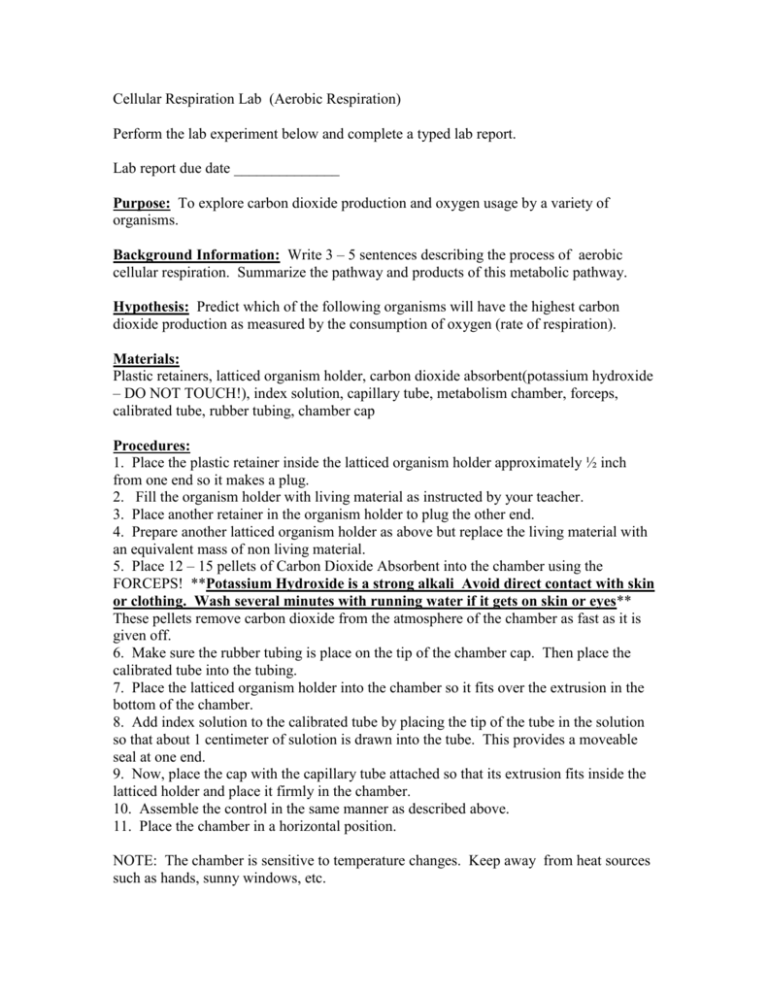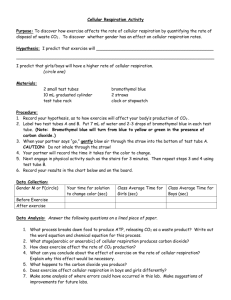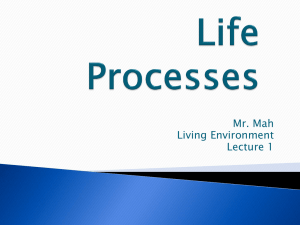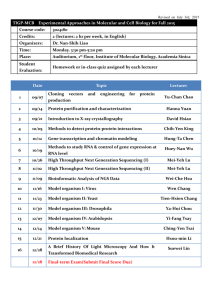Cellular Respiration Lab (Aerobic Respiration)
advertisement

Cellular Respiration Lab (Aerobic Respiration) Perform the lab experiment below and complete a typed lab report. Lab report due date ______________ Purpose: To explore carbon dioxide production and oxygen usage by a variety of organisms. Background Information: Write 3 – 5 sentences describing the process of aerobic cellular respiration. Summarize the pathway and products of this metabolic pathway. Hypothesis: Predict which of the following organisms will have the highest carbon dioxide production as measured by the consumption of oxygen (rate of respiration). Materials: Plastic retainers, latticed organism holder, carbon dioxide absorbent(potassium hydroxide – DO NOT TOUCH!), index solution, capillary tube, metabolism chamber, forceps, calibrated tube, rubber tubing, chamber cap Procedures: 1. Place the plastic retainer inside the latticed organism holder approximately ½ inch from one end so it makes a plug. 2. Fill the organism holder with living material as instructed by your teacher. 3. Place another retainer in the organism holder to plug the other end. 4. Prepare another latticed organism holder as above but replace the living material with an equivalent mass of non living material. 5. Place 12 – 15 pellets of Carbon Dioxide Absorbent into the chamber using the FORCEPS! **Potassium Hydroxide is a strong alkali Avoid direct contact with skin or clothing. Wash several minutes with running water if it gets on skin or eyes** These pellets remove carbon dioxide from the atmosphere of the chamber as fast as it is given off. 6. Make sure the rubber tubing is place on the tip of the chamber cap. Then place the calibrated tube into the tubing. 7. Place the latticed organism holder into the chamber so it fits over the extrusion in the bottom of the chamber. 8. Add index solution to the calibrated tube by placing the tip of the tube in the solution so that about 1 centimeter of sulotion is drawn into the tube. This provides a moveable seal at one end. 9. Now, place the cap with the capillary tube attached so that its extrusion fits inside the latticed holder and place it firmly in the chamber. 10. Assemble the control in the same manner as described above. 11. Place the chamber in a horizontal position. NOTE: The chamber is sensitive to temperature changes. Keep away from heat sources such as hands, sunny windows, etc. 12. Allow the chamber to rest for 3 -5 minutes so gas pressure may reach equilibrium. When the outer edge of the index solution reaches the scale on the capillary tube record this on your data table as the initial reading. For the next 5 minutes record the position of the outer edge of the index solution at one minute intervals for both chambers (experimental and control). You may need to record your readings faster or slower depending on how fast your index solution moves on the tube. Calculate the amount of oxygen consumed per hour by each organism using the following equation: No. of units on tube x 0.01 cc X 60 sec X 60 min. = cc of Oxygen/hour Time in seconds 1 min. 1 hour Calculate the rate of cellular respiration of each organism using the following equation: Cc of oxygen per hour Mass of organism(gm)/1000 = cc of oxygen/kg/hour Data: Time (sec) Organism 1 Organism 2 Organism 3 Control Name__________ Name__________ Name__________ Name__________ Rate of Cellular Respiration Results: Graph the rate of cellular respiration for each organism and the control. Conclusion: Did your hypothesis match your results? Why or why not? Application: 1. What other variables might we have changed to see the effect it would have on the rate of cellular respiration? 2. What other types of organisms might we have used for this experiment? 3. What results would you expect to see of we kept recording data for an hour or more? 4. What might have been a source of experimental error in this experiment?







